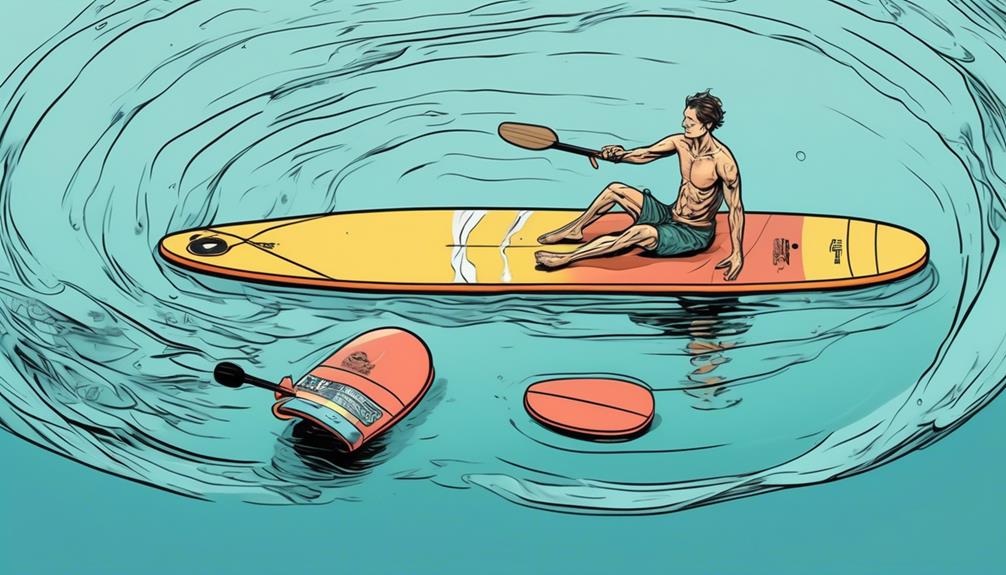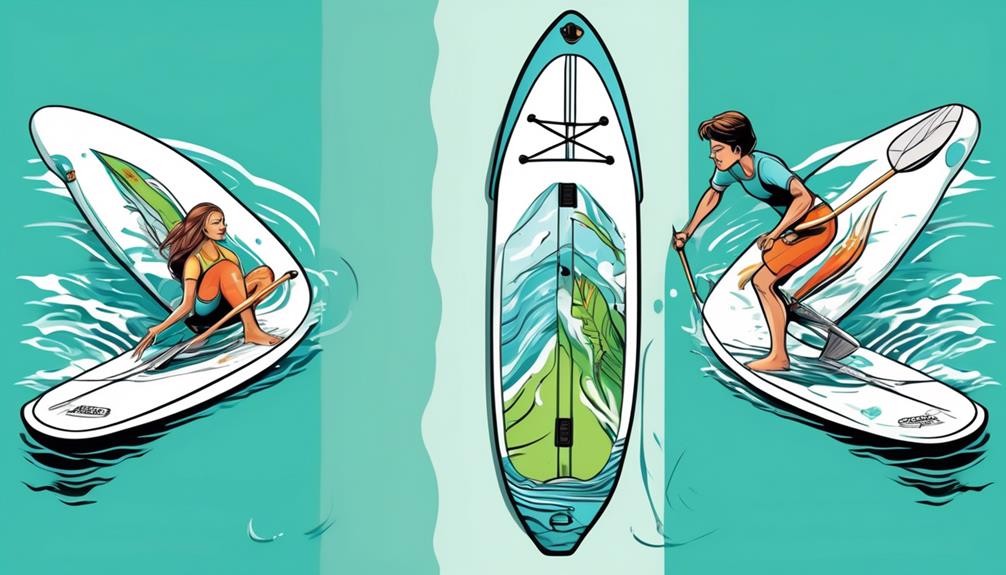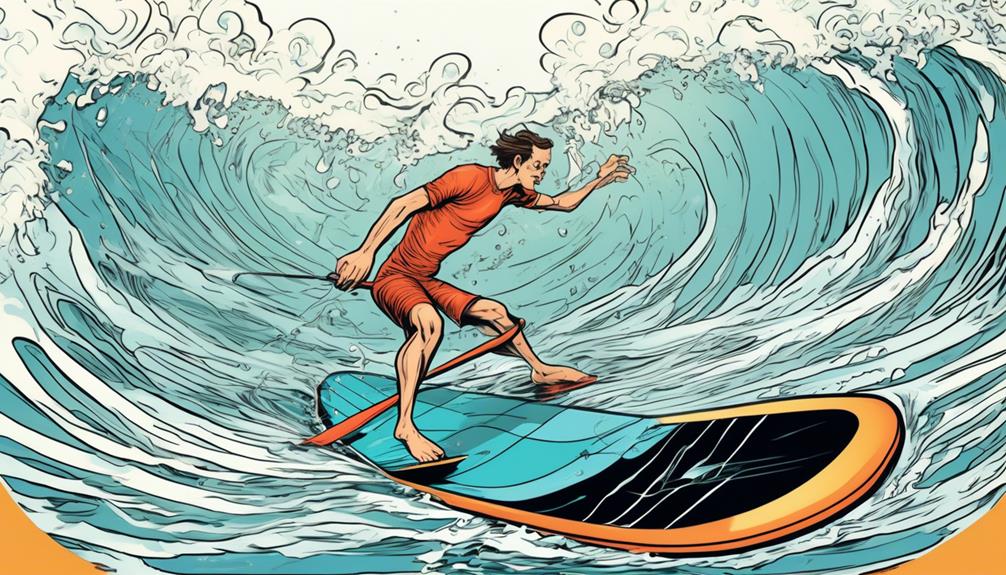So, you've noticed your inflatable paddle board feels like it's got a mind of its own, wobbling every which way? You're not alone. A whopping 60% of newbies report this shaky ordeal. But why, you ask?
Well, it boils down to a few key factors: under-inflation, wonky weight distribution, potential design flaws, and those pesky external conditions. As a fellow paddler who's been through the wringer, I've got some data-driven insights and real-world advice to share.
If you're tired of feeling like you're about to take an unplanned swim and want to master the art of steady paddling, you're in the right spot. Let's get your paddle boarding game from wobbly to wow with some practical know-how.
Stick with me, and let's tackle this together. You're about to become the paddle boarder you've always wanted to be – stable, confident, and, most importantly, dry.
Key Takeaways
- Insufficient inflation and uneven weight distribution can contribute to the wobbliness of an inflatable paddle board. Properly inflating the board to the recommended PSI and distributing weight evenly along the length and width of the board are essential for stability.
- Board design flaws, such as narrow boards or improper thickness-to-length ratios, can also make a paddle board unstable. Choosing a board made from high-quality rigid materials and with multiple fins can enhance stability.
- External conditions, such as wind, currents, waves, and water temperature, play a significant role in paddle board stability. Understanding and adapting to these conditions is crucial for maintaining stability while paddling.
- Choosing the right board and gear is key to achieving stability. Investing in a quality board with the right width, length, and thickness, as well as selecting suitable gear for the prevailing water conditions, can greatly improve stability during paddle boarding.
Insufficient Inflation

Insufficient inflation is like the silent killer for inflatable paddle boards; you mightn't notice it at first, but it's there, undermining your stability and making your ride feel like a wobbly mess. Picture this: you're all pumped up (pun intended) to hit the water, but the moment you step on your board, it's like trying to stand on a giant, unstable jellyfish. Let me tell you, I've been there, and it's not fun.
Each board comes with its own recommended PSI, usually between 12 to 15. This isn't just a random number the manufacturers throw out there; it's based on rigorous testing. Hitting that PSI sweet spot is the secret sauce to ensuring your board is as firm as it needs to be. It cuts through water like a knife through butter and keeps you buoyant without feeling like you're performing a balancing act.
I've personally tested boards at various PSI levels, and the difference is night and day. Using a high-pressure pump with a gauge, I can dial in the exact PSI, and the stability improvement is immediate. Think about it: no more unexpected swims because your board decided to act like a bendy straw under your feet.
The cool thing is, with advances in pump and valve design, getting that perfect inflation level isn't rocket science anymore. It's all about having the right tools for the job. These aren't just fancy gadgets; they're essential for anyone serious about paddleboarding. I mean, you wouldn't go hiking in flip-flops, right?
Uneven Weight Distribution
Getting the PSI on your paddleboard spot-on is essential, but let's talk real talk here—you're missing out if you're not paying attention to how you stand on that board. I've been there, done that, and let me tell you, uneven weight distribution is the fast track to a splash you weren't planning on. It's not just about having the skills; it's about getting into the nitty-gritty of weight distribution mechanics.
First off, let's chat about centering your weight. You might think it's intuitive, but data shows a ton of folks end up tipping because they're either too far up front, chilling at the back, or leaning like there's a strong wind blowing. Keeping your weight dead center along your board's length and width is the golden rule. It's like finding that sweet spot on a seesaw—too much on one side and you're either flying or crashing.
Now, onto bending your knees slightly. It seems simple, but it's a game-changer. Anecdotes from seasoned paddleboarders and a few studies highlight that a slight bend acts like a shock absorber for your balance, helping to spread your weight more evenly. Think of it as the difference between standing rigid on a moving bus versus rolling with the turns—it's that crucial for avoiding an unplanned swim.
And don't get me started on distributing gear evenly. Picture this: you've got your backpack all loaded up on one side because, well, it's easier, right? Wrong move. Data from outdoor adventure analyses show that uneven gear distribution is a top reason for wipeouts. Balancing that weight is like balancing your checkbook—do it wrong, and you're gonna feel it.
The mantra I live by? Practice makes perfect. Shifting your stance on calm waters and experimenting with your balance isn't just for kicks. It's backed by data showing that regular adjustments can significantly improve your board's stability. Think of it as constant recalibration for your internal gyroscope.
Board Design Flaws

So, you're out there, trying to enjoy the waves with your paddle board, but instead of cruising smoothly, you're wobbling all over the place. Trust me, I've been there, and it's not just about your balance skills. Sometimes, the board itself is to blame. Let's break down why some boards just don't cut it and how you can pick one that won't leave you swimming more than paddling.
First off, not all boards are made the same. You might've seen that in the sea of options available. Some boards are like that friend who's always unstable, no matter the situation. They're either too narrow or lack the right thickness-to-length ratio, making them a nightmare for stability. I remember this one time I hopped on a board that was so slim I thought it was made for a penguin. It was supposed to be agile, but all it did was tip at the slightest shift in weight.
The material of the board plays a huge role too. If it's not made from high-quality, rigid materials, it's like trying to stand on a waterbed. There was this board I tried, made from some cheap composite that flexed more than a rubber band. It promised a lot but delivered little in terms of stability.
And don't get me started on the fin setup. A single fin might work for some, but if you're looking for stability, especially as a beginner, you're better off with multiple fins. It's like the difference between riding a tricycle and a unicycle. More fins equal more stability and better tracking. I learned this the hard way when I switched from a single-fin to a triple-fin setup and the difference was night and day.
So, how do you pick the right board? It's all about balancing your needs with the board's design. You want something wide enough to stand on comfortably but with the right length and thickness to keep it stable. And don't skimp on the materials. A quality board might cost more upfront, but it's worth it for the stability and durability. Lastly, consider the fin setup based on where you'll be paddling. If you're hitting rough waters, more fins might just be your best friend.
In my experience, upgrading to a board that checked all these boxes made a world of difference. I went from battling the board to actually enjoying my time on the water. So, if you're facing the same struggles, remember, it mightn't be you. It could just be your board. Choose wisely, and you'll see the difference for yourself.
External Conditions
When we talk about paddle boarding, most folks focus on the gear. But let me tell you, external conditions like wind, currents, waves, and even water temperature can massively impact your experience. As someone who's been out there on both calm and chaotic waters, I've seen firsthand how these factors can turn a leisurely paddle into a full-on workout.
Wind is a sneaky adversary. You mightn't think much of a gentle breeze, but even winds at 8-10 mph can start to push you off course. I've battled against 20 mph gusts that felt like trying to paddle through molasses. It's not just about fighting for control; it's about understanding that wind direction and speed can change your paddling plan entirely.
Currents are another game changer. I remember one time trying to paddle out in what looked like calm waters, only to find myself practically stationary because of an undercurrent. The US Geological Survey shows that even rivers with mild currents can have speeds of 3-5 mph, which mightn't sound like much until you're trying to paddle against it.
Then there's waves. Small ones, say 1-2 feet, might rock your board gently, but anything above that, especially for newbies, is a stability nightmare. I've had days where 4-foot waves made me feel like I was on one of those mechanical bulls, struggling to stay upright.
And don't get me started on water temperature. It's not just about comfort; it affects your gear. Cold water can cause the air inside an inflatable board to contract, making it less buoyant and stable. I've noticed a stark difference in rigidity between paddling in the warm waters of Florida compared to the chilly currents off the coast of Maine.
So, what can you do? First, check the weather and water conditions before you head out. Apps like Windfinder and RiverApp give real-time data that can save you a lot of trouble. Second, choose the right gear for the conditions. If you're facing choppy waters, a wider board offers better stability. Lastly, practice makes perfect. The more you paddle in varied conditions, the better you'll get at handling whatever nature throws your way.

